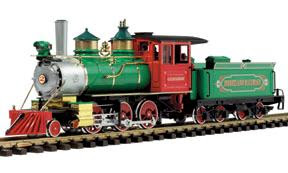 |
| An EMD F7 at the Monticello Railway Museum, Monticello, Illinois, September 13, 2008. Photo by Daniel Schwen |
"The EMD F7 was a 1,500 horsepower Diesel-electric locomotive produced between February 1949 and December 1953 by the Electro-Motive Division of General Motors (EMD) and General Motors Diesel (GMD).
Although originally promoted by EMD as a freight-hauling unit, the F7 was also used in passenger service hauling such trains as the Santa Fe Railway's Super Chief and El Capitan.
The F7 was the Electro-Motive's four(th) entry in its line of freight service locomotives and proved to be one of the most successful designs of any type ever built. The model debuted directly after the F3 in the late 1940s and with EMD's success in the market up to that point railroads quickly placed orders for the F7. Once again, the latest F model proved efficient, rugged, and easy to maintain. Before production had ended on the F7 nearly 4,000 units were produced outselling all other manufacturers' designs, combined. The F7 proved so reliable and useful for many roads that hundreds remained in regular freight service through the 1970s and 1980s (by then replaced by the F 9).
Today, numerous F7's remain preserved (partially due it being the last model of its kind manufactured on a large scale) and some even continue to haul freight, a true testament to their design. The most famous set (a pair of B units) is the fleet owned by Class I Norfolk Southern used as part of its official business train.
Final assembly was at GM-EMD's La Grange, Illinois plant or GMD's London, Ontario facility.
 |
| Courtesy of Wikipedia - Santa Fe F 7 with the Grand Canyon Limited on August 19,1967 |
The F7 differed from the F3, primarily in internal equipment (mostly electrical) and some external features. A total of 2,366 cab-equipped lead A units and 1,483 cabless-booster or B units were built.
Many F7s remained in service for decades, as railroads found them economical to operate and maintain. However, the locomotive was not very popular with yard crews who operated them in switching service because they were difficult to mount and dismount, and it was also nearly impossible for the engineer to see hand signals from a ground crew without leaning way outside the window. As most of these engines were bought and operated before two-way radio became standard on most American railroads, this was a major point of contention. In later years, with the advent of the “road switchers” such as the EMD GP7, F units were primarily used in “through freight” and “unit train” service where there was very little or no switching to be done on line of road.
Identification
There are no easily identifiable differences between late F3 production and early F7 production; the major differences were all internal electrical system changes. However, no F7 had “chicken wire” grilles of most F3s, and no F3s had later F7 changes described below under Phases.
The F9 is distinguishable from the late F7 by having five, rather than four, carbody center louver groups covering the car body filters. The additional one is placed ahead of the first porthole, where F7s have no openings. The F9's greater power output, of course, cannot be seen from the outside.
There were also two main classes of F7's: passenger and freight. The freight locomotives only had one headlight, whereas the passengers has two. " (Quote end)
LGB introduced the first F 7 (A unit) with the # 20570 in 1996 followed in chronological order by
20570 1996
20570.8 1996
21570 1996
21576 1996
20582 1997
20582.8 1997
21582 1997
21586 1997
23570 1998
23582 1998
24570 1999
24582 1999
25570 2000
25582 2000
27570 2000
27582 2000
70657 2000
22578 2001
22578.8 2001
26570 2001
26582 2001
26584 2001
28570 2001
28582 2001
22588 2002
24578 2002
24588 2002
26574 2005
28582 2001eXtra
26570 2005eXtra
+++++++++++++++++++++++++++++++++ to be continued........



































